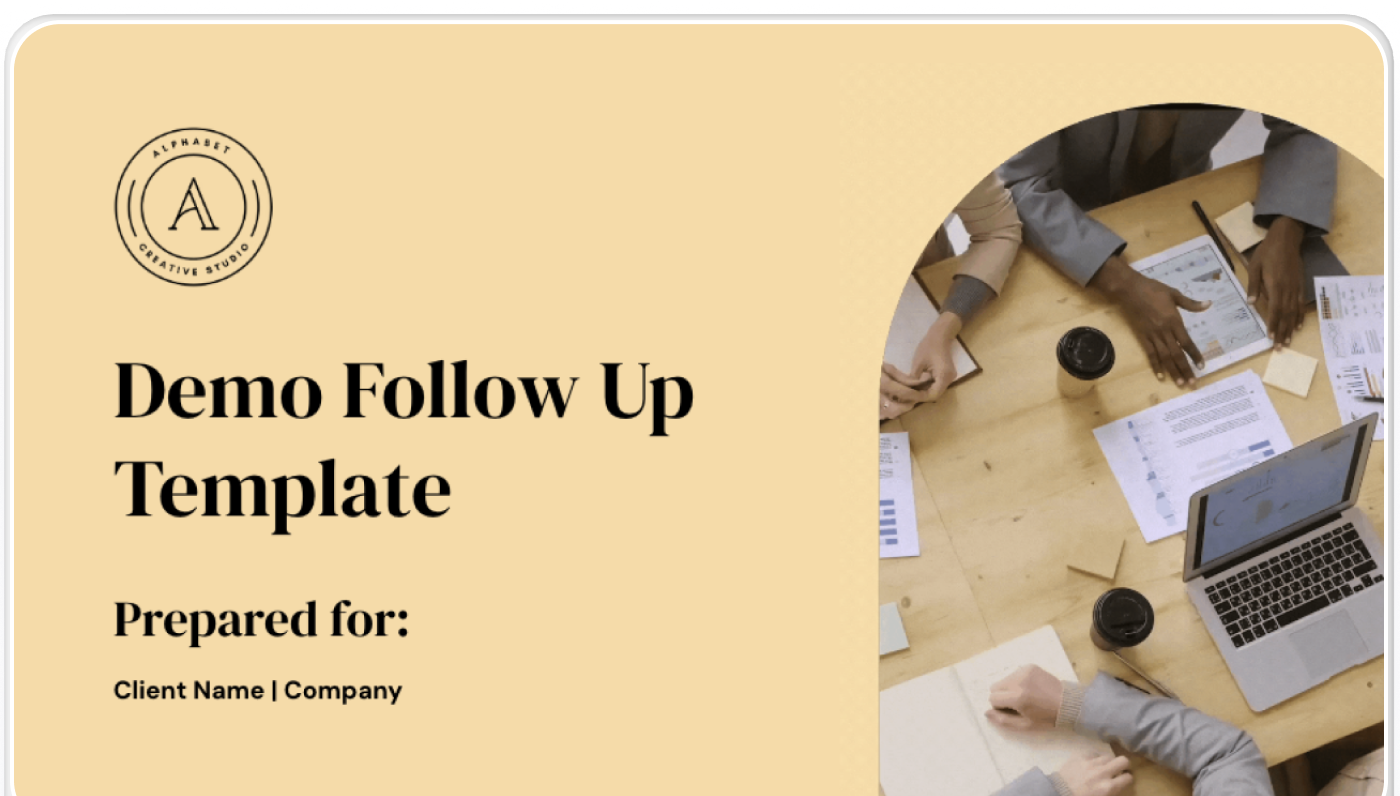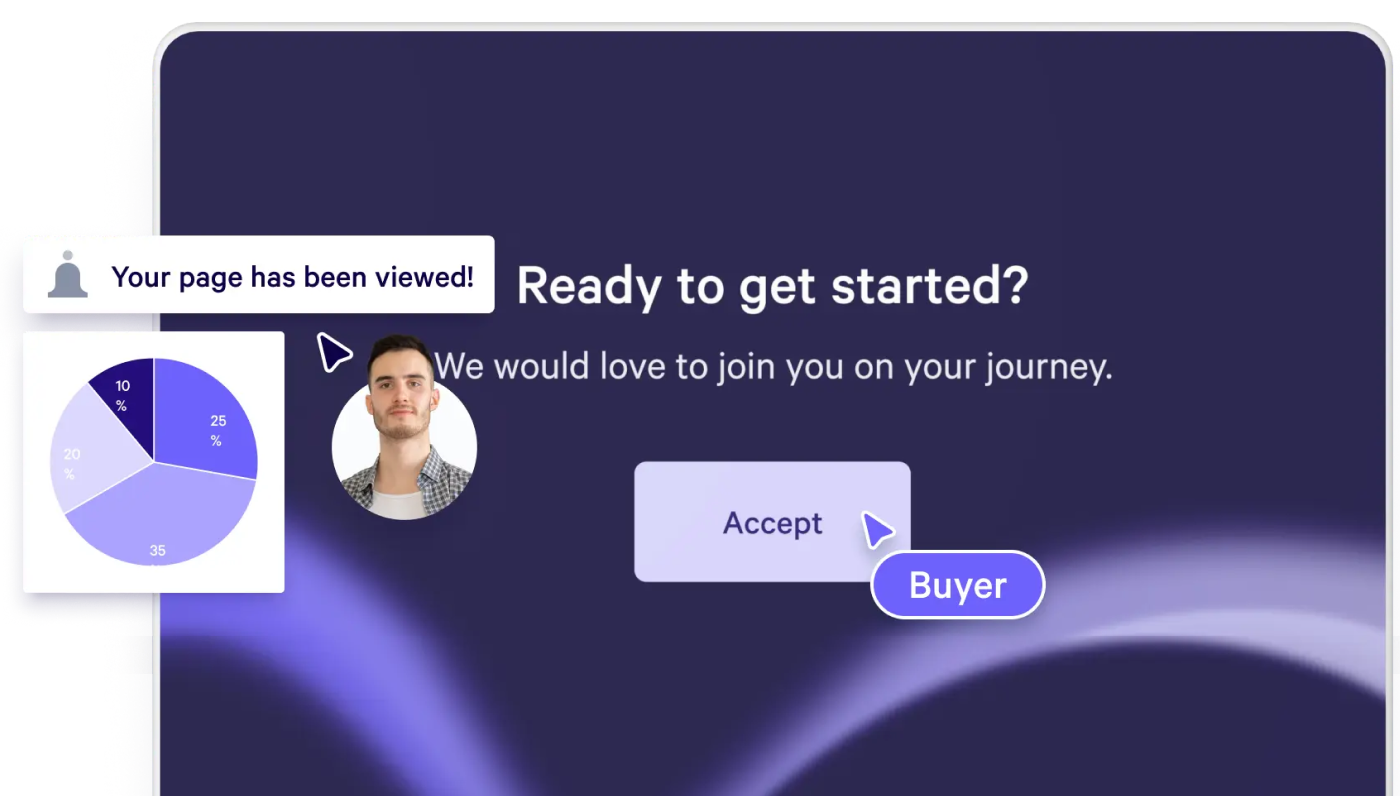
Before COVID, 61% of B2B companies used traditional sales methods. However, lockdowns and social distancing rules have turned the tables. Even today, three years after the outbreak of the pandemic, many businesses are either still remote or embracing hybrid options. Either way, online selling has become embedded in the very fabric of work reality — and the fact that the vast majority of buyers prefer online sales meetings should be enough to turn the pre-pandemic narrative upside down.
Despite buyer preference, virtual selling can be challenging for salespeople. From the nearly-eternal echoes of "Can you hear me" and "You're on mute" to the specific tactics sales professionals need to use to build human connections through a screen, everything in online sales differs from in-person meetings.
Virtual sales make it feel like there's:
- Less opportunity for relationship-building and more for technological blunders
- Less time to get to know your client — but more time for awkward silences
Despite all its downsides, virtual selling also comes with many benefits for everyone involved: buyers, sellers, sales leaders, and the businesses they work with.
The best part of it all? There are many ways you can adapt your techniques to make the most out of your sales meetings – even when they happen behind a screen.
The Benefits of Virtual Selling
Before the pandemic, many business leaders believed remote work would tank productivity and efficiency. And yet, multiple studies have shown quite the opposite: people are more effective at what they do when allowed to work from anywhere.
And that includes remote salespeople too. According to research, sales productivity hasn't taken a hit in the wake of the "new work normal." In fact, 76% of sales leaders believe virtual selling is equally or more effective for prospecting, and several studies cite that remote working increases productivity by 47%.
Even if you were to disregard changing buyer behaviors (but why would you?), there is still a long list of advantages to consider when you embrace online selling.
Here are some of the most important ones:
Reaching more people
Virtual selling allows you to reach more people, regardless of their location. For example, if you’re based in Germany, you can chat with a potential client from Asia in the morning and travel around the world through UK, California, and Australia by the time you log out. With virtual sales, the world is quite literally your oyster.
Adapting to "the new normal"
There's no point in resisting change. Remote and hybrid work is the new normal, so embracing virtual selling can significantly boost market share, reach, and success.
Tapping into a busy market
Your potential customers are busy. They have to juggle more tasks in less time, and, given the context, on a tighter budget too. Meeting them where they are (online) will:
- Help them save time and money
- Make them more comfortable
- Position you as a thoughtful partner rather than a salesperson
Saving time and money
Virtual sales comes with much less paperwork, fewer travel costs and expenses, and quicker communication. You'll be able to cover much more ground in less time, helping you reach (and close deals with) more clients.
Top Virtual Selling Best Practices
Selling in a virtual environment can feel like navigating stormy new oceans; however, the virtual sales process is largely the same as the in-person one. Yet, to succeed at online selling, you must treat it as a very well-planned, transparent process you apply to every potential customer. Here's an example of what that could look like in a virtual environment:
Step 1: Planning
As with any sales meeting, to create successful sales proposals, you must invest time and effort into the pre-meeting planning. The details you iron out now influence the sales process's outcome — so take your time, think things through, and create a plan that fits each potential buyer's specific situation.
At this stage, some of the things you should consider include:
Engaging with the Stakeholders
Take the pre-planning stage as an opportunity to reach out to the stakeholders and do your research. This way, you can reveal any potential questions or objections the buyer may have — and prepare accordingly.
Discussing with Your Subject Matter Experts
Want to make sure you offer the best solution? Contact your internal subject-matter experts to gain reassurance and find ways to make the pitch more customer-centric.
Practicing the Pitch
Your pitch needs to be perfect, so practice with the technology you'll use during the call. Doing this will help you become more comfortable and confident and increase your chances of success.
Rehearsing and Ensuring All Software Is Working Properly
Tech malfunctions are one of the most common — and easily avoidable — reasons sales calls go wrong. Check all your software and have a backup plan if something doesn't work correctly during the meeting.
Prep your prospect
You want your potential client to be in tune with you. So, before the call, send them a quick email outlining your meeting plan, how to access the meeting, what kind of materials they will receive, and what you hope to gain from it. Being clear and concise with your expectations helps build rapport and trust — which is an essential requirement for sales success, regardless of whether you’re face-to-face or virtual. .
Build your presentation
A good sales presentation encourages and fosters conversations, not monologues. Some of the best ways to create sales presentations that keep your prospect engaged include:
- Reiterate the goal of the meeting and the agenda from the get-go. Doing this will help your prospects better gauge their expectations for the call and the sales process.
- Make sure you use every minute of your presentation wisely. You should respect the buyer's time and give them enough information to convince them to buy. Stay organized and try to avoid going off-topic.
- Integrate collaborative and interactive elements in your presentation. Take advantage of the technology you're using — such as collaboration tools or video chat apps — to interact with your audience and ensure they stay engaged throughout the call. Ask questions that lead to further discussions, and make sure you answer any inquiries promptly. Furthermore, you can also alternate between the live video meeting and pre-recorded videos, quizzes, and Q&As.
- Use engaging visuals. Charts, interactive elements, and images should help your prospects better understand what you're trying to sell them and make it easier for them to visualize the potential outcomes.
- Remember to include a call to action in your pitch. A successful sales call should always end with a prompt for the buyer to make a purchase or follow up for details.
If you want to build successful sales proposals easily, you can also use a proven sales proposal template. For instance, you could use:
- An enterprise sales proposal template
- A general sales proposal template you can adapt to your specifics
- A template based on your preferred sales methodology such as MEDDIC sales template, Gap selling template, or SPIN selling template, for example.
These proposal templates are already built for you, so you can create professional-looking, interactive sales proposals your clients can take to their managers and sign right away.
Step 2: Meeting
Once you have all your materials, tools, and communications ready, it's time to jump straight to the meeting. Here are some tips to help you get off on the right foot and ensure your virtual sales call goes smoothly:
- Switch on the camera. This is a time to build rapport with your customer and engage with them, human-to-human – not let them have a call with a black screen
- Show enthusiasm and excitement to keep your prospect engaged throughout the meeting. Be prepared to answer any questions they may have.
- Focus on conversation, not pitching. The best pitches are the ones that feel like actual chats you have with a friend or partner. Your goal should be to have a meaningful dialogue with your prospects and help them make an informed decision. Focus on understanding their needs, pain points, and goals so you can address them with your product or service. Listen, then speak.
Step 3: Post-Meeting
Once the meeting is over, you should:
- Send a Thank You note and a quick follow-up that includes sales materials, videos, and any other resources the prospects may find helpful. Set a timeline for the decision-making process, and make sure you stay in touch until then.
- Document your lessons and build upon them. Even if the meeting was unsuccessful, take some time afterward to review the call and write down your lessons. This will help you improve your virtual selling strategy.
- Send a follow-up in a few days (up to one week). People get busy, and that’s OK – a kind follow-up will help your prospects remember you (and take action, if needed.)
4 Virtual Selling Skills That Will Close More Deals
The same sales skills are needed to close sales deals whether tour sales reps are selling virtually or face-to-face. However, there are a couple of twists that help them transfer their "live" abilities into virtual meetings. Here are some of the skills sales reps should bring into their online efforts:
Technology
Good virtual sales reps must master the technology that enables them to communicate and collaborate with customers. This includes learning how to use video conferencing, presentation, and sales automation tools, so they can effectively "pitch" potential customers without being present in person.
Communication
Naturally, sales representatives need to have excellent communication skills — in person and online. The challenge with online communication is that it's easy to misinterpret things, as facial expressions and body language aren’t always noticeable in the conversation. Virtual salespeople need to have sharp verbal skills that allow them to pick up on cues and interpret the buyer's feelings through a video call. Although this might seem complicated, it is, undoubtedly, more than doable.
(Online) Relationship Building
Building relationships at a distance can feel like a challenge. To begin with, people are sporadic with their long-distance communication. This means that salespeople must be more proactive and persistent with follow-ups. As mentioned before, some body language cues are missing from the equation, so reps need to closely monitor how buyers react throughout the sales process to ensure they stay engaged.
Self-Motivation
Virtual sales reps often need extra motivation to help them drive forward. Setting goals and benchmarks can help support sales reps to maintain momentum in the sales process.
How to Manage a Team of Virtual Sellers
Are you a sales manager leading a team of virtual sellers? Make sure you consider the following tips if you want your team to build a solid selling pipeline.
Encourage overall wellness
Speaking to prospects and clients all day (let alone closing deals) is difficult when you're not feeling your best. On the other hand, when your team members are in the right mindset, they are more efficient and excited about their job—which translates into better results.
Moreover, remote work can cause dips in physical and emotional wellness, especially at the outset. During COVID, 44% of remote workers reported a decline in mental health. Another report found that 91% of remote employees experienced moderate to extreme stress, with 43% becoming physically ill due to stress.
As the experts at HealthMarkets explain, "The body responds to stress on several levels—our muscles tense; blood pressure rises; adrenaline, epinephrine, and cortisol are released, our hearts beat faster, we breathe harder (sometimes hyperventilating), and digestion is put off balance."
"The body responds to stress on several levels—our muscles tense; blood pressure rises; adrenaline, epinephrine, and cortisol are released, our hearts beat faster, we breathe harder (sometimes hyperventilating), and digestion is put off balance."
Healthmarkets
Performance starts with wellness.
To be at the top of their game, your remote sales staff can't be sick, anxious, or unbalanced. As a manager and leader, encourage your team members to prioritize their physical and mental health.
In their guide, Exercise Your Way Into the Flow, Hubgets lays out the scientific research that connects physical fitness with increased focus, energy, and presence. "A consistent exercise regime is essential to accessing the flow both at work and in anything else that you do. It leads to higher productivity, effectiveness, and performance."
Here are a few ways to champion health and wellness for your team:
- Explain the relationship between overall well-being and virtual selling performance via email or team Zoom meetings to set the stage. Use some of the above stats!
- Try a remote exercise or fitness challenge to promote more activity and movement during the day.
- Remember to support work-life balance. Set an example of taking appropriate time off or not emailing or sending Slack messages and expecting answers at off-hours.
Perfect the right balance of communication
If your organization recently went remote, finding the right communication balance can be challenging. (It's even tricky for virtual selling veterans!) You want your employees to feel supported and connected to you but not smothered.
You're not the only one who faces this problem.
An Institute of Leadership and Management study found that 88% of remote workers struggle with inconsistent working practices and miscommunication, while 83% feel overwhelmed by emails.
Kate Cooper, head of research for the Institute, offered advice based on that study's results. "Email is a real problem for remote teams, with overuse consuming huge amounts of time and energy. We found that a lack of face-to-face interaction can lead to feelings of isolation and even paranoia. Regular, scheduled daily or weekly team meetings by video and audio can reduce inefficient email dialogue while also enabling a greater sense of shared identity, values, and purpose."
But how much video chatting is too much? It's a bit of a Goldilocks scenario, and the answer is to find the right combination for your specific team. To refine your communication balance:
- Understand the difference between asynchronous and synchronous communication. When in async, team members are not expected to give immediate answers, whereas real-time communication and collaboration are required in synchronous teams.
- Incorporate pre-recorded video into the mix. Are there updates you want to share with your team but aren't time-sensitive? Record and send a video they can watch and respond to at their convenience.
- Establish a meeting-free day of the week. This can be a time for heads-down work or allowing your team to focus on meeting quotas without internal communications getting in the way.
- When in doubt, ask! Poll your staff on their communication preferences.
- Always be willing to adapt. You might need to adjust communication practices during busy seasons.
Offer flexibility and autonomy
Everyone works differently, especially in our "new normal." Some people are early risers and most productive in the morning. Others prefer to burn the midnight oil. And some team members might be juggling children at home with virtual school or need to squeeze in lunchtime appointments.
Flexible schedules are one of the best perks of virtual selling. According to a recent Buffer report, 40% of workers said a flexible schedule is the most significant benefit of remote work.
As a manager, make sure you're allowing your team the autonomy to take advantage of that flexibility. While many businesses likely need to keep a semblance of "core business hours," when possible, allow for wiggle room in working schedules.
Check in with your team about their individual workflow. Ask them when they feel most productive or if they have personal commitments throughout the day.
Showing you trust your team enough to offer flexible schedules and autonomy empowers them in their virtual selling role. Moreover, it shows you care about them as a person, not just an employee. Empathy is a powerful driver; 78% of employees confirm working harder for an empathic leader.
Prioritize learning and development
Learning and development aren't limited to new concepts—it can include brushing up on existing workflows. Now is the time to check in with your team members and ensure they understand and correctly utilize your current sales tools.
Your organization likely employs multiple digital resources—CRMs, proposal platforms, project or task management tools, virtual selling tools, communication portals, and so on. You'd be surprised how often people might not use those tools or processes to their full advantage.
Poll, or survey, your team to pick their brains about your digital tools versus their workflow. Ask pointed questions and request honest feedback to understand how often they use each tool.
Based on the results, offer a judgment-free opportunity for refresher sales training on critical systems. Your company invested in that technology; you should empower your team to understand and use them to improve productivity or efficiency. Depending on your vendor, you could even reach out for a tutorial on new features/functionality.
To take L&D a step further, have 1:1s with team members to get a feel for their aspirations. Are they looking to make an upward move (or lateral)? Is there another role they're interested in? Do they want to expand into management?
Understanding their goals helps you provide learning and development opportunities within your company. (As a bonus, this also increases retention—86% of millennials say career training and development would keep them at their current company).
Boost your sales teams' performance
The landscape of B2B sales is forever changed. According to McKinsey research, a positive aspect of that evolution is that more than three-quarters of buyers and sellers now prefer digital/remote interaction. To make sure your sales team succeeds in the new remote world, you need to adapt and refine your management style.
All the strategies on this list accomplish an essential objective—building a trusting, solid relationship between you and your remote sales teams. Trust is the foundation of virtual selling and a productive and engaged couple.
About the author

Brendan Connaughton|Head of Growth Marketing
Brendan heads up growth marketing and demand generation at Qwilr, overseeing performance marketing, SEO, and lifecycle initiatives. Brendan has been instrumental in developing go-to-market functions for a number of high-growth startups and challenger brands.




